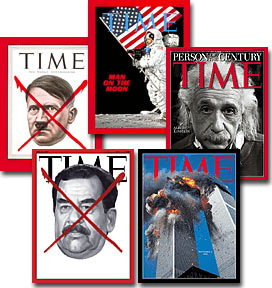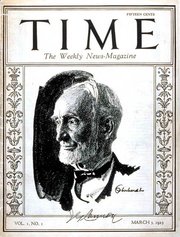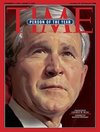Time (magazine)
|
|
Time (officially capitalized TIME) is a weekly American newsmagazine, similar to Newsweek and U.S. News & World Report. A European edition (Time Europe, formerly known as Time Atlantic) is published from London. Time Europe covers the Middle East, Africa and (since 2003) Latin America. An Asian edition (Time Asia) is based in Hong Kong. A Canadian edition (Time Canada) is based in Toronto. In some advertising campaigns, the magazine has noted that the letters time stand for "Today Information Means Everything."
| Contents |
History
The first issue of Time was published on March 3, 1923, featuring on its cover Joseph G. Cannon, the retired Speaker of the United States House of Representatives. Preceding both of its major competitors, Time was the first weekly news magazine in the United States. It was co-founded in 1923 by Briton Hadden and Henry Luce. Both had worked together previously at Yale, with Hadden and Luce serving as chairman and managing editor, respectively, of the Yale Daily News. Hadden died in 1929, and Luce became the dominant man at Time and a major figure in the history of 20th-century media. Hadden was a rather carefree figure, who liked to tease Luce and saw Time as something important but also fun. That accounts for its tone, which many people still criticize as too light for serious news and more suited to its heavy coverage of celebrities (including politicians), the entertainment industry, and pop culture. It set out to tell the news through people, and for many decades the magazine's cover was of a single person. People magazine was originally inspired by Time's People page.
Style
Time has always had its own writing style, parodied most famously in 1938 by Wolcott Gibbs in an article in The New Yorker: "Backward ran sentences until reeled the mind … Where it all will end, knows God." The early days of incessantly inverted sentences and "beady-eyed tycoons" and "great and good friends," however, have long since vanished.
The magazine has only ever published one official editorial, in 1974, calling for the resignation of Richard Nixon.
Time is also known for its signature red border, which only changed once in the magazine's eighty year history—the issue released shortly after the September 11, 2001 attacks on the United States, which featured a black border to show mourning.
Mergers
Time became part of Time Warner in 1989 when Warner Communications and Time, Inc. merged. Since 2000, the magazine has been part of AOL Time Warner, which subsequently reverted to the name Time Warner in 2003.
Man of the Year
The magazine's most famous feature over its 80 years has been the annual Man of the Year cover story, in which Time recognizes the individual or group of individuals who have had the biggest effect on the year's news. In 1999, this feature was renamed "Person of the Year." Despite the title, the recipient is not necessarily an individual -- in 2003, it was "the American soldier" -- or even a human. In 1982, the home computer was recognized as "machine of the year".
Albert Einstein was Time's person of the century in its last edition of 1999.
Controversy has occasionally arisen due to the designation of hated figures as "Persons of the Year." The distinction is supposed to go to the person who, for good or ill, has most affected the course of the year; it is therefore not an honour or reward. In the past, such figures as Adolf Hitler or Joseph Stalin have been Persons of the Year. The magazine backed down from this policy for its Person of the Year in 2001: the feeling was that the person who had most affected the course of the year was Osama bin Laden, but the editorial board weighed the policy against the risk of inciting outrage, and named Rudolph Giuliani instead.
Time For Kids
Pokemon.PNG
Time For Kids is an division magazine of Time Magazine, that's specially published for children and is mainly distributed in classrooms. TFK contains some national news, a "Cartoon of the Week", and a variety of articles concerning popular culture that young ones may be interested in. One annual issue concerning the environment is distributed near the end of the U.S. school term. The publication hardly ever ranges above fifteen pages front and back.
External links
- Time online (http://www.time.com/)
- Time Archive (http://www.time.com/time/magazine/archives) - Archive of all magazines and covers from 1923 through present
- Table of Contents of the Inaugural Issue (http://www.time.com/time/magazine/0,9263,7601230303,00.html) on March 3, 1923
- Time Europe (http://www.timeeurope.com/)
- Time Asia (http://www.timeasia.com/)
- Time Canada (http://www.timecanada.com/)
- Time For Kids (http://www.timeforkids.com/TFK)bg:Тайм
de:TIME es:Revista Time id:TIME ja:タイム (雑誌) nl:Time no:Time Magazine pt:Time sv:TIME Magazine zh:時代 (雜誌)



